NEAGP 2018
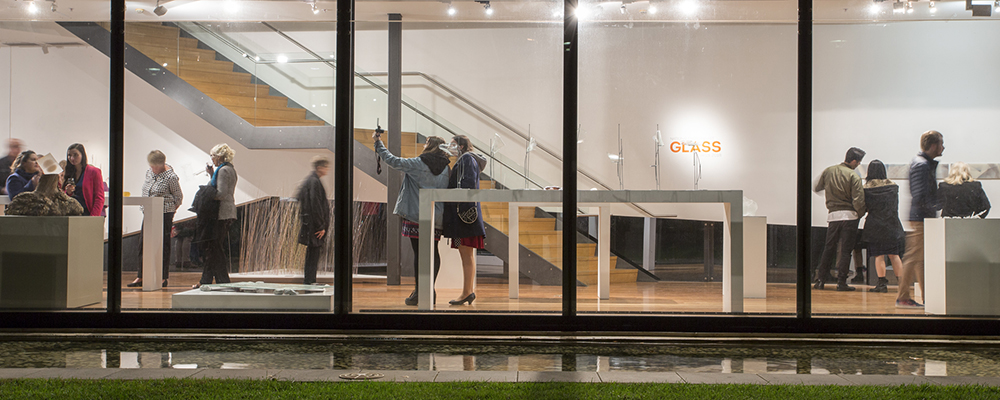
- National Emerging Art Glass Prize 2018, Opening Night
The fifth instalment of Wagga Wagga Art Gallery’s acclaimed National Emerging Art Glass Prize is currently on display at the National Art Glass Gallery from 5 May to 29 July 2018 – and for the first time will also travel to Griffith Regional Art Gallery from 10 August to 23 September 2018.
The Prize is a biennial competition launched in 2010, and was established to reward and promote innovation and excellence in contemporary glass within the emerging sector.
The NEAGP will be open to students from universities across Australia and artists that are within 5 years of emerging from their studies. The winner will be announced at the official launch of the exhibition on Friday 4 May 2018.
The winner will receive an all-expenses paid masterclass study trip to North Lands Creative Glass in Scotland and $4,000 prize money, in exchange for the acquisition of their work for the National Art Glass Collection, to be held alongside Australia’s most acclaimed and significant glass artists.
NEAGP 2018 Winner
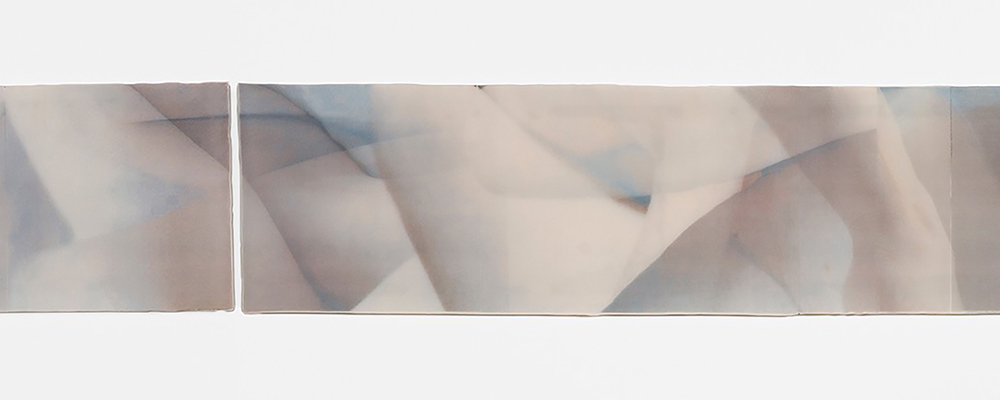
- Rose-Mary Faulkner, Continuum 2017 (detail), kiln formed glass and decals
My current work presents a study of my own body from the restricted, subjective line of sight we have of ourselves, aiming to map the female figure through abstracted and layered photographic imagery in order to analyse form and surface. I investigate ways to observe and experience the body, expressed visually through soft dappled imagery, evocative of feeling and sensation. Exploring decals techniques, I transfer photography to glass with water and heat, combining several related images before further manipulating the surface. Continuum presents a mapping of my form – its shape, folds and colours – and its delicacy is enhanced with a skin like surface and sensation.
NEAGP 2018 Finalists
Clare Peters, Hope Upheld 2017, multiple layered fused glass, 22ct gold text, Mallee root base This work explores the use of multiple layered fused glass, light, and timber, to give physical expression to the realm of faith and hope. In Hope Upheld, glass and wood capture the juxtaposition of spiritual light and earthly form. The glass cube containing a sculptural form – text from the Psalms, suspended in space - creates a place for inspiration, revelation and hope. The timber of the mallee gum root supports the cube, containing the Word of God – Christ Himself, God incarnate - Hope Upheld |
Namdoo Kim, Expendable Being 2017, glass/core-casting The images within my works draw upon the imagery of toys and I use these within glass sculptures to illustrate the entrapment of young minds within a social system that is dehumanizing. The cynical and subversive aesthetic of Pop has shaped my thinking in that it is a critique of 60’s culture through ideas of absurdity / humour and assists in my conveyance of current cultural critiques. |
Rose-Mary Faulkner, Continuum 2017, kiln formed glass and decals My current work presents a study of my own body from the restricted, subjective line of sight we have of ourselves, aiming to map the female figure through abstracted and layered photographic imagery in order to analyse form and surface. I investigate ways to observe and experience the body, expressed visually through soft dappled imagery, evocative of feeling and sensation. Exploring decals techniques, I transfer photography to glass with water and heat, combining several related images before further manipulating the surface. Continuum presents a mapping of my form – its shape, folds and colours – and its delicacy is enhanced with a skin like surface and sensation. |
Hannah Gason seeks to recreate those fleeting moments of truly contemplative experience. Her works explores gesture and structure using repetition made up of colour, line and surface textures. Her creative process is reflective and intuitive, and inspired by her experiences in the Australian landscape. Watching, waiting ii alludes to repetition of act and of thought and the routines of life. The coloured glass strands mimic glass fronds, yet they evoke a greater feeling as the colours catch the light and gently sway and overlap. |
My work contemplates the mysteriousness of the internal, specifically the relationship between the internal and the external, to create subtle forms that suggest the presence of something ambiguous beneath the surface of the material. The subtle tensions created in the material are what interest me to explore, and challenge, the potential of kiln formed glass. By putting these tensions into dialogue with each other, I aim to evoke a sense of push and resistance between form and material, inviting the interplay of black and light and prompting the temptation of touch. |
The idea of escaping Earth and inhabiting distant planets is now referred to as plan ‘B’ if Earth warms beyond 2 degrees, the tipping point of dangerous global warming. The word Nebulae means mist or cloud and also alludes to a vague, ambiguous or ill-defined concept. Inspired by observations of the moon and constellations while working with an astro-photographer, this work repurposes discarded and shattered glass to capture the ideas of hope and energy embodied by glass and light. |
The impact that natural environments can have on our emotions is what I investigate. I’m inspired by liminal spaces, the transition spaces between different environments. This work expresses the emotions triggered by watching sunrise over water, watching days begin or nights end, sinking into the experience. The work is an abstraction, with the sculptural form made up of fluid layers, echoing the changes and transitions in our moods and thoughts. |
The glass pieces are the result of an experiment, where float glass where put vertically upright in the kiln. Slumping can be reasonably predictive, but with the glass vertical made sure that the results were unique and unpredictable. The glass precariously balances on stands that were specifically fashioned to hold and to best accentuate the curving forms of each piece, without encroaching the shape of the glass but to activate the incredible sense of movement in the glass. This balance creates a precarious relationship, as the glass is fragile, balanced on a prong, which brings it in motion but also brings it so much closer to being motionless. |
In Asphyxia I have used The Great Barrier Reef as metaphor to explore my anxieties about the destructive nature of humanity and the current trajectory of our planet. The work explores the complex interrelationships of human and non-human nature and challenges classical ideologies that honor a radical split between the two. Asphyxia is my attempt at preserving and documenting the harmony between man and earth at a point were we are desperately trying breaking apart. |
Balloon sculpting is a playful art realising the potential of air coupled with a membrane to yank, squeeze and bow a given shape. Blown from glass, each of the sculptures in this series mimic those actions in an effort to yield small details in each of the contortions and textures emerging from the material performance. The immediacy of the actions are revealed dynamic through application of colour rod glass, acrylics, and enamels. |
To convey the connection between mother and child through the sense of touch, mothers from the Canberra community assisted me in making glass hugs of their children. In this work, Fiona chose colours to represent each of her children, creating individual forms, that she inflated, in hot glass I hugged these forms to create the glass hugs. An analogy is drawn between hugging hot glass, intimidating and invigorating, and that of being a mum, which is also daunting and stimulating. |
This piece aims to channel the emotional response of Empathy. The Iridescent glass sheets slumped over the mould of a face, look as though there are two lovers in their satin sheets. By fusing segments of dichroic glass over the mouth of the female (pink) face & forehead of the male (blue) face I wanted to symbolise the different ways we interpret & react to emotions. |
This exploratory series engages the notion of collecting, experimentation and material investigation and what can be revealed through presentation of such things. I am interested in exploring the optical qualities of glass and its ability to distort or provide clarity to something through an experimentally formed lens. These lenses both house the deceased body of the butterfly to allow one to observe the detail within this specimen, yet also to slow down the disintegration process. Butterflies are almost invisible in the way that they move so quickly, yet their life cycle is also rather fleeting, one is able to pause and reflect on this mortality. |
‘The power of the written word “ comes into play when referencing the history of the Australian Sugar Cane industry from 1863-1910. The practice of “Blackbirding” or kidnapping of Polynesian men is represented by the void between reality, and the lies. The pen represents the instrument of power that supported the righteousness of the colonisers with the hidden truth represented by the shadows of the oral history. |
‘Stylus’ is a continuation in the series of works exploring my family’s dialogue with print. It is a celebration of innovation, the rising of potential creation and my own sculptural evolution. This piece suggests a playful and joyful reminder of the simplicity of drawing, which at its essence is an extension of hand and mind. ‘Stylus’ is a rudimentary tool employed and adapted to a multitude of variations, its functionality embedded in our society as an extension of ourselves. |
I first saw that rug and noticed it had been worn through where the feet and knees go. How many times did she pray on it? It was grandmother’s rug. The shapes slumped, creating the holes are based off her marks. The title is from a poem by Rumi, I have used it as a methodology. The distorted, textured mirror provides limited self-reflection, supported the very stones that could break it. This work draws parallels between worship, reflexivity and love. |
Inside Outside relates to the connections between the inside of the home and the exterior to the home. Two dynamic forms of technology and nature coming together, connecting to make one form. Representing nature, as it adapts and revolves around its uninvited host. Separated by environment, but able to exist as one entity. Inside and Outside is a one – piece sculpture that consists of two connected moulded glass components, a mushroom top and a plug. Bonded to each side of a steel mesh plate. |
I am captivated by the visual collision of opposing forces; positive and negative, volume and flatness, light and shadow. The tension between these binary forces is the influence for my studio practice. Illuminate explores these themes using geometric coldworked glass forms that shift both in colour and appearance. The shifting quality of the work is activated through both the viewer’s perception and vantage point as well as different light sources. |
What is potential? The hope of infinite possibilities or the fear of leaving them unfulfilled? We come into this world isolated and small, curled in and clutching to ourselves without knowing our true identity. Yet, already a promise has been made to an unseen future swelling beneath the surface our fragile vessels. Through the translucent glass of the baby’s body, we glimpse a face/possibility of what it may grow to become but without further polishing it remains unclear, raw and buried - waiting for its potential to be fulfilled. |
Orchestrated Agency, is a material investigation into blown glass. A methodological commitment using glass inclusions was practiced as an examination of the multi agential elements of the making process. Experimenting with sculptural form, allowing the material to be moved as I am equally moved by the material. This exploration and dedication was passionately motivated in search of beauty. Beauty is experienced through the interactions with the material. The orchestration of agencies created objects which are traces of the devotional practice. |
In the Self Objectification series I use the mechanics of blown glass—the expansion and contraction of material due to my breath and physical manipulation—to distort the engraved image of the female body. I create literal objects of myself to communicate my experience of body dysmorphia. The soft surface finish and colours reminiscent of meat increase the bodily aspect of the work. The traditionally female shapes, ovoid and goddess, provide ample room for distortion of the image. |
How I navigate and perceive the world is through the lens of my body. This current work explores the tension between the subjective experience of being a body and the accumulated knowledge discovered by the objective examination of the body. The isolation and examination of bodily components enable an ever changing understanding ofthe body. In this work I utilise discarded scientific glass and other found glass objects, augmenting and repurposing them to explore this tension. |
The Nintendo Gameboy was such a big part of not only my upbringing; but that of children growing up all around the world. I have always had a fascination of the 8-bit imagery these early consoles created. I use these games to connect with people who have shared experiences of playing these games and evoking a sense of nostalgia. Using the glass process called murrini; I recreate these images in glass and create simple forms. Really playing with the imagery. |
This work responds to a particular moment in nature, looking closely at an illuminated leaf full of texture and details. I used my open-hearted approach to material investigation in making this form, purposefully blowing the glass too thin in order to create texture, bubbles and tonal changes within the glass. transforming the form into 2D using a kiln to make the macro details in the surface more prominent, I ask us to look deeper into the glass and reflect upon captivating moments in nature. |
My work combines glass processes to create simple geometric forms that examine interlocking systems. Inspired by nature and architecture, I have built a scheme where units merge to create sets expanding into larger systems. The formation of the structures relies on the materiality of glass - clear, fluid and structural - and the ability to cast blown bubbles to create the connections. The emphasis on the link between the two processes, blowing and casting; one cannot work without the other. |
The Gall Wasp is a parasite that lives in citrus trees, eventually killing them. I experimented with casting the masses that the Gall Wasp creates in the branches of citrus trees. The Gall wasp lays its eggs inside the stems of lemon trees forming cancerous lumps on the fragile sticks. The casting process involved making plaster moulds, burning out the stick and then filling and firing the mould. These delicate sculptures show the fragility of nature. |
Conduit V and Conduit II present as hyper-sigils for transformation. Their bodies act as conduits for an undomesticated otherness, the omnipresent abyss existing behind and within the profane. Working alongside labour and time intensive materials such as alloys, glass, stone and polyurethane, I employ synesthesia (mingling of sensory experience) and intuition as tools to harmonize typically dissonant phenomena. A mythologised system is born against the backdrop of profane, consensus reality. The conflicted union of materiality; suspended fluids and gentle metals |
I have worked as a production glassblower for the last four years. I seek to investigate the narrative of traditional forms through the practice of making by hand. I am currently exploring the historical use of preserving bottles and the hourglass, or sand-clock. The bodily form of the hourglass, and its translating function, explore ideas of absence and presence. The movement of the sands record time through a repetitive changing internal landscape. Bottles and hourglasses are the historical precedent to my current work, both relying on internal spaces which hold and move light. These contemplative works present an interlinking of meditative process and sculpture. I have enjoyed making these works; blowing them initially and then filling them with glass sands. The process of making them has fed my ideas and, by continuing to invest in this challenging material, I hope to keep bringing my ideas to life. |
I draw the political and personal together in intimately woven glass threads. I link my works with Julia Kristeva’s process of ‘abjection’ as matter, which is from the body but repelled and rejected from the self. Drawing on the abject, repetitive crafting and making becomes an active process of positively dispelling trauma out of the body into the object. This is an empowering process, sharing of memories that are held close and carried and an intimate recognition of memories which one attempts to estrange. |
Catalogue
Links
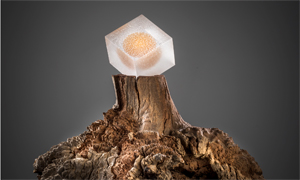 Highly Commended
Highly Commended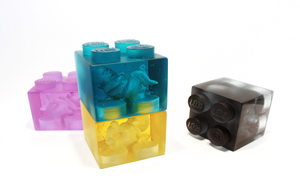 Highly Commended
Highly Commended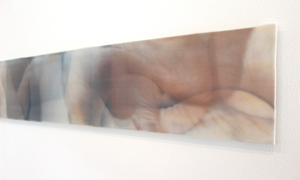 Winner
Winner 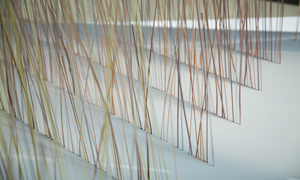 Hannah Gason, Watching, waiting ii 2017, pulled glass strands, wooden plinth
Hannah Gason, Watching, waiting ii 2017, pulled glass strands, wooden plinth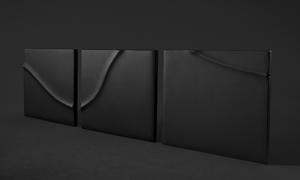 Madeline Cardone, Undulate 2017, kiln formed glass
Madeline Cardone, Undulate 2017, kiln formed glass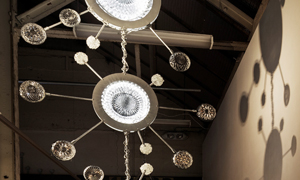 Ngaio Fitzpatrick, Nebulae 2017, found and fused glass ,steel, LED lights
Ngaio Fitzpatrick, Nebulae 2017, found and fused glass ,steel, LED lights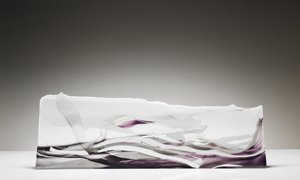 Debra Jurss, Alpha and omega 2018, hot and kiln formed glass, hand polished
Debra Jurss, Alpha and omega 2018, hot and kiln formed glass, hand polished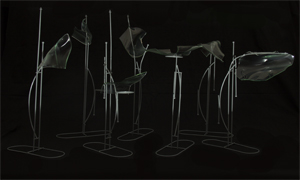 Bermi dryer, Breathless 2017, slumped glass
Bermi dryer, Breathless 2017, slumped glass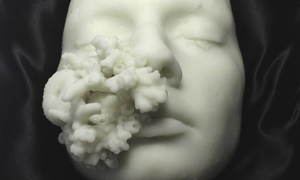 Sorcha Yelland, Asphyxia 2017, cast glass
Sorcha Yelland, Asphyxia 2017, cast glass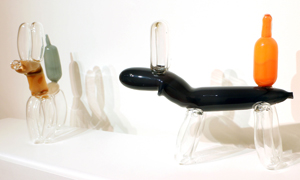 Billy Crellin, Yank, Squeeze, Bow 2017, blown glass, sculpted
Billy Crellin, Yank, Squeeze, Bow 2017, blown glass, sculpted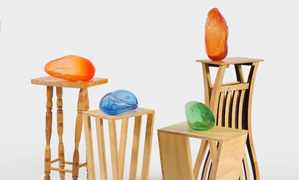 Catherine Newton, Mum's Hug Jesse, Oscar, Isaac, Riley 2017, blown, hot sculptured, cold-worked glass and timber
Catherine Newton, Mum's Hug Jesse, Oscar, Isaac, Riley 2017, blown, hot sculptured, cold-worked glass and timber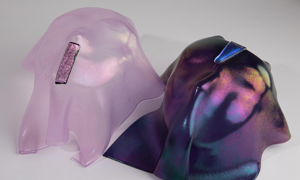 Corey Nicholaidis, Fragile Faces 2017, fused and slumped sheet glass with dichroic inclusions
Corey Nicholaidis, Fragile Faces 2017, fused and slumped sheet glass with dichroic inclusions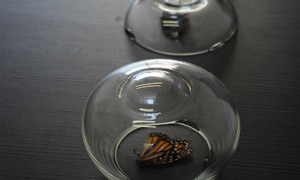 Fleur Tui May Bain, Reflection through the lens? 2017, blown and cold worked glass, butterfly specimens (supplied by the Melbourne Zoo)
Fleur Tui May Bain, Reflection through the lens? 2017, blown and cold worked glass, butterfly specimens (supplied by the Melbourne Zoo)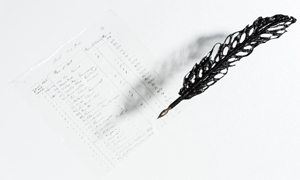 Glenda Kent, Shady History 2017, pate de verre, paper
Glenda Kent, Shady History 2017, pate de verre, paper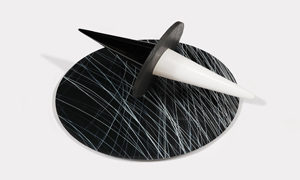 John White, Stylus 2017, blown glass, wood and metal
John White, Stylus 2017, blown glass, wood and metal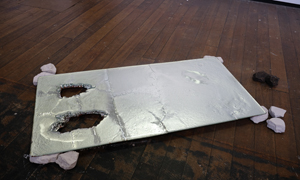 Lara Chamas, I am your mirror, here are the stones 2017, float glass, bronze, cement, slumping, slivering and casting
Lara Chamas, I am your mirror, here are the stones 2017, float glass, bronze, cement, slumping, slivering and casting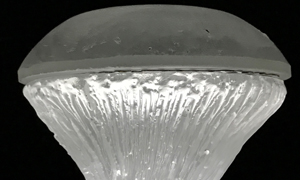 Lisa Mann, Inside Outside 2017, cast glass, metal
Lisa Mann, Inside Outside 2017, cast glass, metal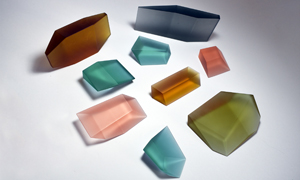 Madisyn Zabel, Illuminate 2017, cold worked glass
Madisyn Zabel, Illuminate 2017, cold worked glass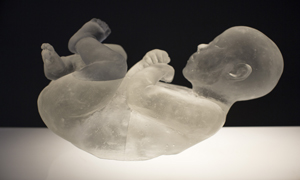 Nancy Yu, Potential 2018, cast glass
Nancy Yu, Potential 2018, cast glass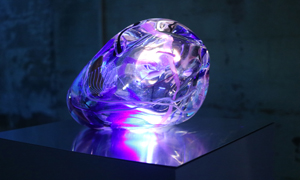 Laura Nolan, Orchestrated Agency 201, blown glass, aluminium and video
Laura Nolan, Orchestrated Agency 201, blown glass, aluminium and video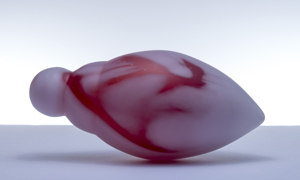 Nadina Geary, Self Objectification #5 2017, graal, engraved and coldworked
Nadina Geary, Self Objectification #5 2017, graal, engraved and coldworked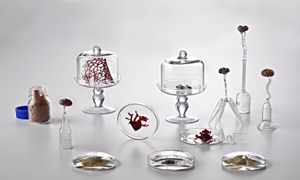 Naomi Hunter, Anatomy Study 2018, flame worked, borosilicate and found glass
Naomi Hunter, Anatomy Study 2018, flame worked, borosilicate and found glass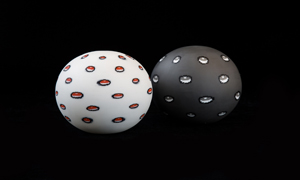 Nick Adams, Poke – Sphere, Breath, Poke – Sphere, Gotcha 2018, glass, murrini and rollup
Nick Adams, Poke – Sphere, Breath, Poke – Sphere, Gotcha 2018, glass, murrini and rollup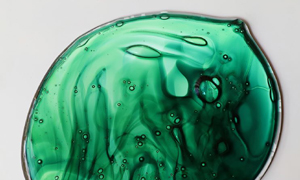 Rachael Harris, Illunimante 2017, blown and slumped glass, lightbox
Rachael Harris, Illunimante 2017, blown and slumped glass, lightbox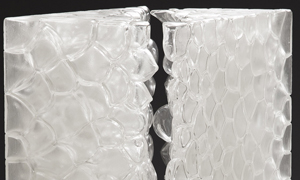 Robert Schwartz, Composed Systems I 2017, blown and cast glass
Robert Schwartz, Composed Systems I 2017, blown and cast glass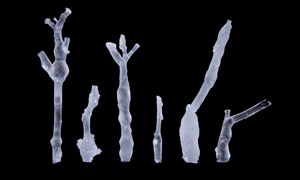 Ruby Hogenbirk, Lemon lumps 2017, cast glass
Ruby Hogenbirk, Lemon lumps 2017, cast glass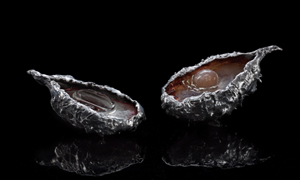 Seven Valencia, Conduit II 2017, aluminium, polyurethane, sterling silver, glass, orthoclase, oil pigment
Seven Valencia, Conduit II 2017, aluminium, polyurethane, sterling silver, glass, orthoclase, oil pigment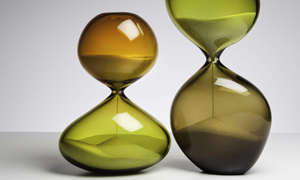 Thomas Pearson, Wax and Wane 2018, blown glass
Thomas Pearson, Wax and Wane 2018, blown glass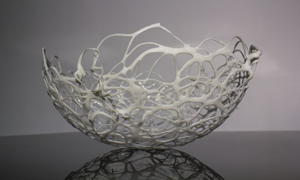 Ursula Halpin, Cuimhnigh an Bearna II (Mind the Gap II)
Ursula Halpin, Cuimhnigh an Bearna II (Mind the Gap II)